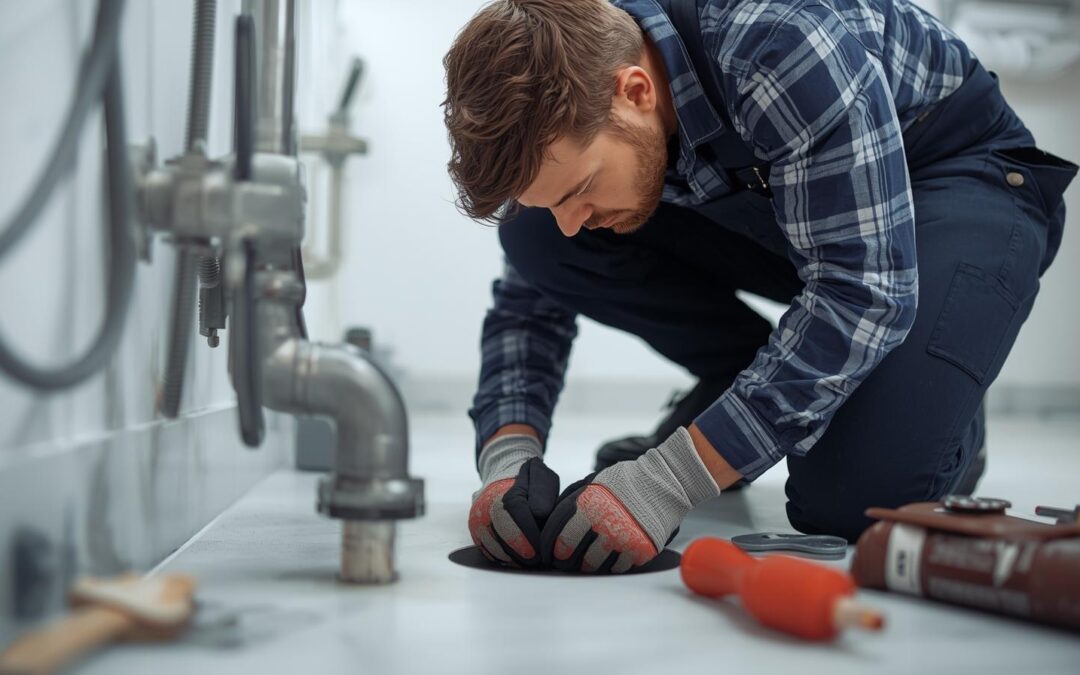Heavy rain can do more than soak streets and slow traffic. For commercial property owners in Columbus, particularly in older or low-lying neighborhoods, it can mean thousands of dollars in cleanup, repair costs, and downtime caused by sewer backups.
While some level of weather-related disruption is inevitable, the most costly outcomes are often the result of preventable failures in a building’s plumbing system infrastructure. For businesses without an effective plan in place, a single significant backup can deliver immediate financial impacts and indirect consequences in the form of operational disruptions, physical damage, and long-term reputational damage.
How Sewer Systems in Columbus Work and Why They Fail
Columbus operates on a separate sewer system. That means stormwater and sanitary sewage are carried in dedicated pipe systems. Ideally, sanitary and raw sewage remain safely apart. During periods of intense rainfall, however, stormwater systems can exceed their designed capacity.
When that happens, excess water can infiltrate sanitary systems or even overwhelm combined connections, posing a significant threat in neighborhoods with aging or improperly maintained infrastructure. That influx of additional water creates pressure, forcing water and sewage back up through drainage pipes and into buildings, often through floor drains, toilets, and utility sinks.
In some cases, cross-connections between storm and sanitary systems, though technically and operationally outdated, still exist. These vulnerabilities can make commercial properties susceptible to backups, even when routine plumbing appears to be in good working order. It’s a bit like having a hidden leak that goes unspotted until damage appears.
Aging sewer systems in Columbus’s historical areas contribute significantly to these risks. Pipes laid decades ago might not be equipped to handle the increased volume of stormwater associated with changing weather patterns and the higher demand that growing populations impose on sewer systems, or they may have deteriorated to the point that they’re no longer capable of keeping the two streams separated.
The Flood-Prone Zones of Columbus
Not all neighborhoods face the same level of risk. Properties in historically flood-prone areas — Franklinton, Hilltop, and parts of Linden, for example — see more frequent issues, especially in buildings with basements or below-ground mechanical systems.
The city’s Division of Sewerage and Drainage and FEMA floodplain data provide important guidance for identifying these zones, where factors such as elevations, proximity to streets with insufficient drainage, and groundwater saturation can increase the chances of flooding and backups during severe weather.
It’s not just limited to designated floodplains, though. Localized topography can play a significant role as well. For example, a business situated at the bottom of a long, gentle slope may be surprisingly vulnerable during a downpour, as water would be naturally directed toward the foundation.
Checking historical flood maps and understanding drainage patterns is of critical importance for commercial business owners to avoid the damaging effects of standing water in the streets and potential sewer system overload.
Core Prevention Strategy #1: Backwater Valves
Among the most effective tools for preventing sewage from entering a building is the backwater valve. Designed to integrate directly with a building’s sewer line, these one-way valves allow wastewater to exit while preventing backflow. These systems are designed to automatically close when a reverse flow of water is detected, effectively sealing the building’s drainage system from the municipal sewer.
Columbus building code requires backwater valves in certain areas, particularly those with a history of backups. Code compliance doesn’t guarantee complete protection, though. Backwater valves must be inspected and cleaned annually to remain effective. Neglecting maintenance, especially before storm season, can render them useless when they’re needed most. Debris, grease, and even small objects or tree roots can impede their ability to fully close, leaving a gap for water to enter. Regular professional servicing ensures the valve’s components are clear, lubricated, and operationally ready at all times.
Core Prevention Strategy #2: Sump Pumps and Elevation Solutions
Where backwater valves protect against water ingress, sump pumps help manage water from below. Installed at the lowest point of a structure, these pumps activate automatically when groundwater levels rise, directing water away from the building’s foundation. This is particularly important in buildings with basements or underground crawl spaces where hydrostatic pressure can force groundwater up through floors and walls. A reliable sump pump system is one of the most effective lines of defense against subsurface water intrusion.
Modern water mitigation systems often include battery-powered failover systems to deliver power to critical equipment during power outages. Some also feature high-water alarms that alert facility staff to issues before flooding occurs. In buildings that are particularly vulnerable to water and sewer backups, elevating key mechanical systems like HVAC units and electrical panels can reduce the risk of damage if even a minor intrusion occurs. Raising the level, even by a few inches, can make a significant difference in protecting costly equipment and maintaining operational functionality during and after a flood event.
Staying in Compliance with the Columbus Division of Sewage and Drainage
The Columbus Division of Sewage and Drainage plays a critical role in both response and prevention efforts. Commercial property owners are expected to document sewer backup incidents and maintain records of their mitigation strategies.
Beyond the requirements of the city, thorough record-keeping can support insurance claims and shield properties against liability, especially in multi-tenant or shared-use buildings where backup damage can extend beyond the property owner.
Maintaining detailed logs of maintenance, service visits, and any incidents demonstrates responsible management, which can provide added advantages in mitigating legal or financial burdens that inevitably follow after the event has occurred.
What Ongoing Maintenance Looks Like
No system is invincible, and even the best infrastructure requires upkeep. Servicing sump pumps, backwater valves, and drainage systems isn’t a “set it and forget it” scenario. Without consistent checks and maintenance, effectiveness dwindles, and the risk of malfunction or failure climbs. A building’s location and layout determine how often and how thoroughly it needs to be inspected, but it’s a matter of good practice that shouldn’t be overlooked.
- Inspect and service backwater valves annually to ensure they’re free of debris and functioning properly.
- Test sump pumps regularly, including checking battery backups and high-water alarms.
- Clear roof gutters, downspouts, and catch basins to prevent clogs and pooling that can lead to system overload.
- Schedule professional flood-readiness assessments to identify hidden vulnerabilities in drainage and sewer systems.
- Document all inspections, maintenance, and service calls for insurance and MSD compliance purposes.
- Check grading around the property to ensure water is being directed away from the foundation.
- Inspect for signs of pipe deterioration or intrusion, especially in older buildings or those in high-risk zones.
Take Action Before Backup Happens
Sewer backups often happen without warning, but that’s no reason to ignore the threat they pose. In many cases, a combination of outdated systems, neglected plumbing maintenance, and unrecognized risks creates vulnerabilities that many property owners don’t recognize.
Sewer backups don’t wait for a convenient time, but proactive planning and maintenance can avoid the expense and headaches involved with recovery. In Columbus, Enervise helps businesses identify vulnerabilities, maintain critical systems, and prevent the disruptions that sewer backups can cause. Contact us today to schedule a backup system evaluation.




